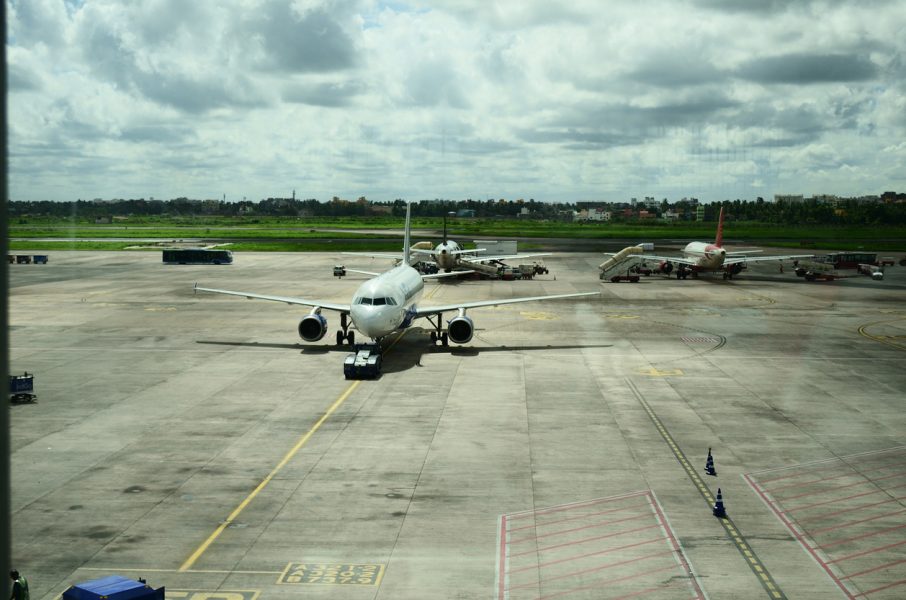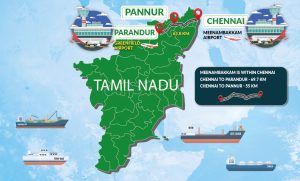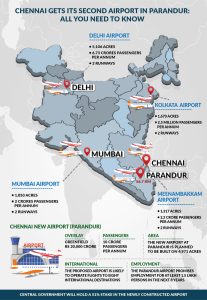
Chennai airport II: How far will Parandur greenfield project fly?
The location, currently a nondescript village, offers adequate space, but its distance from the city and the green clearance requirements pose daunting challenges

Pannur, Parandur, Padalam and Thiruporur were short-listed to host Chennai’s second airport, and this was subsequently narrowed down to the first two. Parandur finally made the cut.
Anyone who knows Tamil would agree it couldn’t have been more apt — parandur means ‘a town with spaces wide open’. If one overlooks the nuances of the two Tamil ‘r’ sounds, parandur literally means ‘a town that flies’.
That’s about where the aptness ends, quip critics of the new airport proposal.
It has been a week since the new airport in Parandur was formally announced. Several details have emerged — such as the cost, the spread and timeline, and the massive scale of the greenfield project. What could be worrying, though, are the details that are yet to come out — such as land acquisition, environmental clearance and the question of how Chennai and its second airport will be connected.
Pannur vs Parandur
Ever since the joint decision of the Union and Tamil Nadu governments was announced, the top-most query has been — why Parandur? Pannur’s geographic proximity to Chennai would have made it a better choice, it was pointed out.
Also read: Work on Chennai’s second airport to start by September: Scindia
Countering the claim, a Tamil Nadu government official involved in the project told The Federal that the state government had never seriously considered Pannur. “The pre-feasibility report given by the Airports Authority of India (AAI) had said both Pannur and Parandur were feasible for the project. However, the state government felt Parandur is more financially feasible for the airport. Pannur never found a place in the proposal of the state government.”

“Media reports have tried to create a misleading impression that the government changed its decision from Pannur to Parandur,” said an official from Tamil Nadu Industrial Development Corporation Limited (Tidco), the nodal agency for greenfield projects in the state. Pannur was dropped because it already has many townships and industries, the Tidco official added.
“Some people say that the distance from Chennai to Pannur (about 55 km) is short compared to Parandur (about 69 km). That may be true. But distance alone cannot become a base for choosing a site.”
Thangam Thennarasu, TN Industries Minister
Talking to The Federal, Thangam Thennarasu, state Industries Minister, said that all the four sites chosen initially by the state had their own challenges. “Some people say that the distance from Chennai to Pannur (about 55 km) is short compared to Parandur (about 69 km). That may be true. But distance alone cannot become a base for choosing a site,” he said.
Land acquisition
The need for a second airport for Chennai was first formally stated in 1998. Since then, the greenfield project has been in the pipeline, never taking off. The biggest gap in the blueprint was land availability.
Now, the perceived availability of land appears to have weighed in Parandur’s favour. But, how exactly the government expects to acquire land remains unknown.
Parandur, in Kancheepuram district, has a geographical area of about 1,328.11 hectares. Its literacy rate is less than 60 per cent, and its population of 2,556 is largely dependent on farming.
There have been reports of Parandur residents expressing shock at their not being consulted ahead of the decision. While they are fairly confident of getting compensation, the loss of farming livelihoods is daunting. There is no major industry in the area that can immediately absorb them.
Minister Thangam Thennarasu, however, is confident that the issues can be ironed out. “In Parandur, some farmers have started opposing the project,” he told The Federal. “It can be addressed by having talks with them.”
Development and construction
Tamil Nadu Chief Minister MK Stalin, while announcing the project, said its cost estimate is ₹20,000 crore. It will supplement the current airport at Meenambakkam, which is within Chennai, and will have the capacity to handle 10 crore passengers per year, he added. Details around the break-up of the ₹20,000 crore, and the funding route, are yet to be shared.

It is claimed that it would take at least five to seven years for the airport to become operational.
The Tidco official said that since greenfield airports are typically constructed under the public-private partnership (PPP) model in India, it is likely to be replicated in Parandur. GMR, GVK and Adani are among the airport developers and operators in India. The Meenambakkam airport is run by the AAI. “We have not yet decided on the companies. That will be done once we get all the clearance,” the official added.
Stalin said that the airport would be developed with two runways, terminal buildings, taxiways, apron and cargo terminal besides maintenance and other required infrastructure.
The need for a second airport
That Chennai needs a new airport in addition to the existing one is rarely disputed. The international airport at Meenambakkam is the sixth busiest in passenger traffic in India. On an average, about 400 aircraft movements are recorded per day.
According to a statement issued by the Tamil Nadu government, the existing airport handles 2.2 crore passengers every year. It is expected to handle nearly 3.5 crore passengers annually once the expansion at Meenambakkam is completed, in about seven years. At that point, it would reach saturation.
Also read: It’s official: Chennai to get second airport at Parandur
There is little scope for further growth because the airport is bang in the middle of the city. The Parandur airport would be a substantial bonus. It would sport two bigger runways than the Meenambakkam one, which means it can handle bigger aircraft, with seating capacity of over 600.
Once the Parandur airport becomes operational, how the traffic will be divided between that and Meenambakkam is yet to be decided. Officials at Meenambakkam airport said they cannot comment on it. Tidco officials said this will be discussed at a much later date since, right now, even the DPR is not completed.
The distance factor
“The average distance travelled by a passenger to Parandur airport will be 73 km, and the average time taken will be 1 hour and 54 minutes, as against the 21 km and 54 minutes taken to travel to the present Chennai airport,” said the AAI report on the greenfield project.
Pannur’s distance from Chennai has been the theme of memes and cause for much concern in Tamil Nadu. People are pointing out that flying from, say, Bengaluru to Parandur would be pointless, as the local commute times at the cities of origin and destination would be several times the flying time. Whether the existing road infrastructure can handle the movement of crores of passengers between Chennai and Parandur everyday is also debatable.
No other Indian city has two airports, so a comparison is not possible. The Hindon Airport in Ghaziabad, Uttar Pradesh, is considered a second airport for Delhi, but its distance from Indira Gandhi International Airport is just 38 km. There are examples abroad, but the road and rail infrastructures are barely comparable. For instance, Narita Airport is nearly 74 km from Tokyo, but the average commute time is just an hour.
What does work in Parandur’s favour is that it is located within 15 km from the Chennai-Bangalore National Highway. So, there is existing road infrastructure that can be scaled up.
Extending Chennai Metro may be imperative to the success of the new project. Shuttle services that give passengers quick and affordable transport options, particularly with baggage, are a must.
Environmental clearance
The environmental clearance for the airport project could prove a challenge. Of the 4,791 acres finalised for the site, 2,605 acres are wetlands. Parandur has a lake that hosts migrant birds every year. Tufted ducks, flamingos and common pochards are frequently spotted during the season.
While there is little information in the public domain on the ecological feasibility of the project, it is bound to attract criticism at some point. The airport is set to feature two runways. If parallel runways are to be built, an additional 200 acres of land would be needed.
How well the state and Union governments bury their differences, iron out the problems and ready the airport within the deadline would make it one of India’s most keenly watched infrastructure projects.


